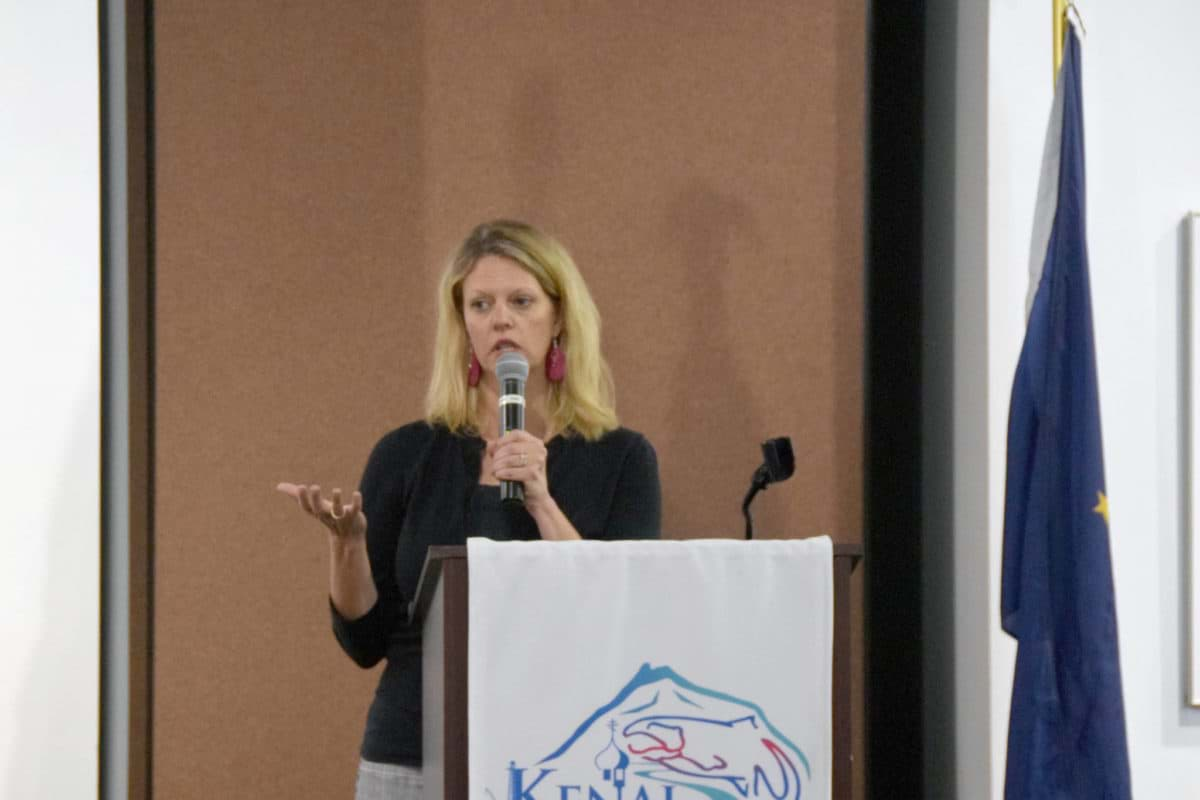Alaska Oil and Gas Association President Predicts Decades of Increased Oil Production

At the Wednesday, Aug. 21 luncheon, Kara Moriarty, President and CEO of the Alaska Oil and Gas Association, broke down the industry’s outlook for the next couple of decades and addressed the renewed conversation around tax credits for oil companies.
Moriarty
started the presentation by speaking about a new initiative from the oil and
gas association that highlights the individuals working in the industry. A
Facebook Page for Alaska Oil and Gas features videos and testimonials that
“celebrate the people and the pride and the petroleum industry.”
“It
may seem funny to you in Kenai that we need to do something like this, but
you’re an unusual community compared to the rest of the state because the
industry really is right in your backyard,” Moriarty said. “We’re trying to
provide an opportunity for the rest of Alaska to see what life is really like
for those of us who live and work in the industry.”
Moriarty
also highlighted the statewide economic impact of the oil and gas industry.
According to data from the McDowell group, the industry provides over 103,000
direct jobs and more than $6 billion in wages each year. When including
indirect jobs, the McDowell study showed that the oil and gas industry
represents about one-third of all jobs in Alaska.
In
addition, information compiled by oil and gas association and presented to the
Alaska House Resources Committee in May showed that the industry provided $3
billion dollars in total revenue to the state and local governments during
Fiscal Year 2020.
Moriarty
said that the oil and gas industry operates primarily in the Cook Inlet and the
North Slope. There are also three refineries in the state: The Marathon
refinery in Nikiski and two refineries owned by Petro Star in Valdez and the
North Pole.
Looking
to the future, Moriarty said that the North Slope is set to experience a
“renaissance” in terms of renewed growth in production within the next decade.
Moriarty said that this past year was the most successful season in terms of
exploration that the state has seen in over 15 years. As part of the
presentation, Moriarty shared a map of the National Petroleum Reserve in Alaska
(NPRA) that illustrated the various projects being proposed in the area.
Companies
like Oil Search and Hilcorp are looking to infield developments in the NPRA,
and Moriarty said that if all goes according to plan, oil production could
increase significantly.
“Now
all of those fields aren’t going to come online all at the same time,” Moriarty
said. “But if they are all successful … we could honestly see in five to seven
years a couple hundred thousand more barrels being produced.”
On
Tuesday, BP announced that it would be selling all of its interests in Alaska
to Hilcorp for $5.6 billion. Moriarty told the Clarion yesterday that the news
of the sale bolstered the notion that companies are committed to increase
production both on the North Slope and in Prudhoe Bay.
“I
have no doubt Hilcorp will do everything they can to expand BP’s existing
operations, and this is another opportunity to see what they can do with
Prudhoe Bay,” she said.
Looking
at the long-term outlook for the industry, the impending lease sale in the
Arctic National Wildlife Refuge (ANWR) could also mean a huge boost in
production for the next generation of oil and gas. The federal Energy
Information Administration recently updated their long-term outlook for oil and
gas production to account for potential production in ANWR.
According
to information from the Energy Information Administration, even without
production in ANWR the U.S. has become the largest petroleum producer in the
world, passing Saudi Arabia in 2018. The U.S. currently produces about 12
million barrels of oil per day and is also the world’s largest producer of
natural gas, producing more than 110 million cubic feet per day.
Moriarty
said that with a successful lease sale, by 2040 there could be rates of
production as high as 1 million barrels a day in ANWR alone. Moriarty said that
this increase in production is necessary to meet a global increase in demand
for oil and natural gas. The International Energy Association’s 2018 World
Energy Outlook outlines the potential for oil demand to increase steadily over
the next few decades, with demand peaking at 106 million barrels per day in
2040. The increased demand is expected to come primarily from countries in the
Asia Pacific region.
To
end her presentation, Moriarty spoke about the latest initiative to reform the
current tax structure in Alaska in regards to the oil and gas industry. On Aug.
16, an application was submitted for a ballot initiative called the Fair Share
Act that would increase the state’s share of revenues from oil production by
increasing taxes on oil companies and eliminating the per-barrel tax credit
that is currently in place.
The
per-barrel credit, enacted through the Legislature in 2013 with the passage of
SB 21, acts as a tax deduction for oil production that is adjusted as the price
of oil fluctuates. Moriarty said that the goal of the per-barrel credit is to
keep the tax rate competitive when oil prices are low, and the credit
diminishes based on rising price. Prior to the passage of SB 21, oil production
was taxed at a flat 35%. According to a presentation by Alaska’s Department of
Revenue to the House Resources Committee on April 22 of this year, the
effective production tax rate with the per-barrel credit has averaged about 24%
since fiscal year 2014.
“I’m an Alaskan, I’ve got three kids in school, I understand the state has a serious fiscal challenge,” Moriarty said. “So some think this a really easy fix, we can just go get a billion or two from the oil and gas industry, but in the end that will not be the long-term solution and we’ll be worse off long-term than in the short-term.”
